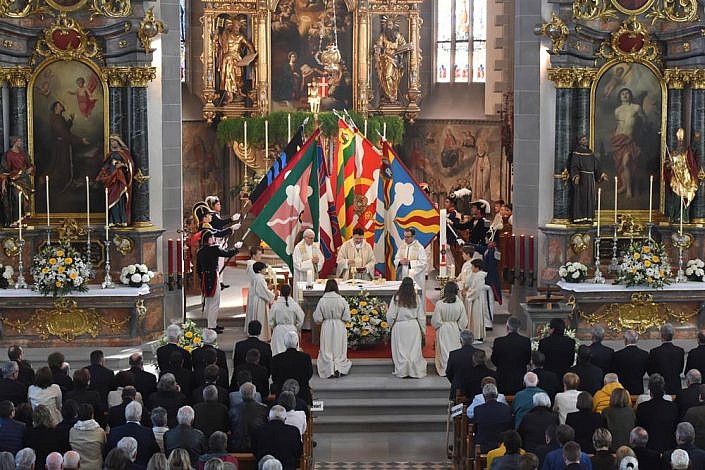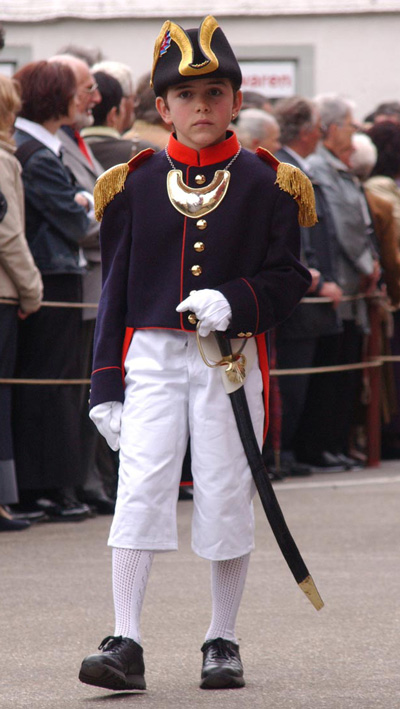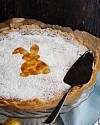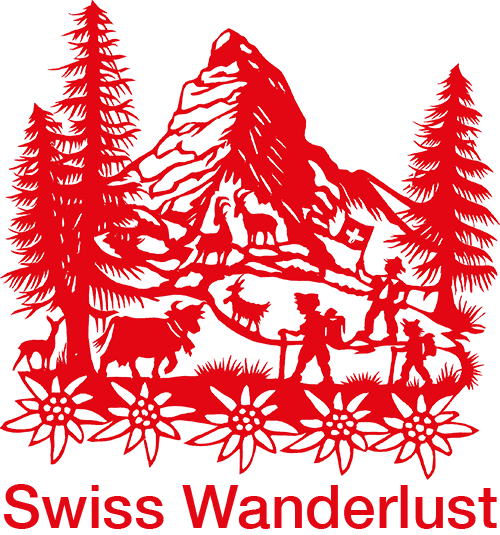The air is crisp and the sky deep blue on this Sunday morning in April, when eligible citizens in the spectacular Canton Appenzell Inner-Rhodes come together to embody one of the oldest forms of living democracy. With a population of under 16,000 spread across 174 gorgeous square kilometers, this small Canton upholds a political practice that dates back to the Middle Ages. (To provide a comparison, Canton Appenzell Inner-Rhodes would fit over one hundred times into Lake Ontario).
Appenzell Landsgemeinde Service
The ceremonial part starts with the Landsgemeinde service at the parish church. The word Rhodes in German refers to wood cutting, which began in the Appenzell region in the 11th century. St. Mauritius church was built around the same time and became one of the most richly decorated in Switzerland.
 On the main street coming into town earlier I had passed the President of the Government on his bicycle pedalling at good speed, his black ceremonial gown flapping in the wind, complemented by a black top hat and sword dangling by his side. Now in town, the church bells are calling people and they stream in from every direction in their Sunday best. Everyone knows everyone; greetings and smiles are abundant. Young and old, men and women, families, locals and tourists, with a noticeable amount of young men, smartly dressed in suit and tie, holding their ceremonial sword. All are mounting the stairs that lead up to the parish church.
On the main street coming into town earlier I had passed the President of the Government on his bicycle pedalling at good speed, his black ceremonial gown flapping in the wind, complemented by a black top hat and sword dangling by his side. Now in town, the church bells are calling people and they stream in from every direction in their Sunday best. Everyone knows everyone; greetings and smiles are abundant. Young and old, men and women, families, locals and tourists, with a noticeable amount of young men, smartly dressed in suit and tie, holding their ceremonial sword. All are mounting the stairs that lead up to the parish church.
 Choir and strings are settled in the loft, all seats are taken and the swords rest on the pew hooks. The procession of clergy down the center aisle signals the start of the service. They are followed by flag bearers flanked by a young squire on either side, in turn followed by the clad-in-black cantonal councillors, and guests of honor. The sermon draws parallels to the Appenzell Landsgemeinde with the learnings of five hundred years of reformation and six hundred years of Brother Klaus, the Swiss peace maker and nation-father. The festive atmosphere is augmented by powerful church music and ends in a moving Agnus Dei performance by the mens’ choir.
Choir and strings are settled in the loft, all seats are taken and the swords rest on the pew hooks. The procession of clergy down the center aisle signals the start of the service. They are followed by flag bearers flanked by a young squire on either side, in turn followed by the clad-in-black cantonal councillors, and guests of honor. The sermon draws parallels to the Appenzell Landsgemeinde with the learnings of five hundred years of reformation and six hundred years of Brother Klaus, the Swiss peace maker and nation-father. The festive atmosphere is augmented by powerful church music and ends in a moving Agnus Dei performance by the mens’ choir.
Appenzell Landsgemeinde Procession
There is time for lunch after the ninety minute service. Government officials settle with their guests in one of the historic restaurants, locals take in the sun with a standing apéro, and others enjoy a comfortable folk place to eat the typical Appenzell Landsgemeinde lunch: Appenzell Siedwurst, potato salad and Landsgemeinde-Chrempfli, the traditional baked goods for this occasion.
After lunch, everyone re-assembles in front of the Town Hall for the traditional procession to the voting square. With measured step at the head of the procession walks the Landweibel (usher) with his scepter. Closely following are Presidents and Council in their official black cloaks. (Note that they are bare headed on the way to the Appenzell Landsgemeinde. In a later photo you see them return from the voting area, confirmed as the newly elected Council, now walking with their black top hats on their head.) Flag bearers in colorful historic costumes and guests of honor follow, accompanied by music group Harmonie. Tourists and visitors are closely pressed against the buildings lining the narrow streets, mere inches from the procession.
Close to three thousand voters are waiting assembled within the voting area. Men have the option to still use their sword to identify voting privileges, women use voters cards. Under a cloudless blue sky with the sun burning relentlessly, the Appenzell Landsgemeinde develops its business in over three hours.
Appenzell Landsgemeinde Voting
When St. Moritz, the great bell in the church tower falls silent, the Landammann opens the assembly. After the election of the new Presidents and Council, the presiding Landammann, followed by the eligible voters, swear the Landsgemeinde oath. It is a goose flesh moment when the entire assembled community speaks the oath as one and raises their right arm high above their heads for the oath.
The government provides an account of its activity and the budget, then proceeds to the political agenda. At any point of the proceedings, each person entitled to vote has the opportunity to advance to the podium and argue for or against an issue, put forward a suggestion or submit a new initiative. Voting is always done by a show of hands.
I couldn’t help but be impressed by this solid and ceremonial process of direct democracy, literally held out in the open, – visible and clear for all to witness, participate and be heard in. While the Appenzell Landsgemeinde is not without criticism chiefly because of lack of anonymity during the voting process, it is an event that clearly brings people and their government into direct and immediate contact in a way that other parts of the world can only dream of.
If you’ve ever experienced the Appenzell Landsgemeinde, I’m certain you will leave a comment below. This is an experience not soon or easily forgotten!





















Leave a Comment Below
Your email address will never be shared. Your comments make my day. Thank you!More from Swiss Wanderlust
Very unique Easter tradition in Ferden/VS
Swiss Easter traditions - old & new
Pegasus Zürich where Easter bunnies & Santas rendez-vous
Sent, Ftan, Guarda & Schellen-Ursli
Of tree stands & Christmas mice
Santa traditions in Switzerland
Swiss Christmas traditions
Start your backyard composting this fall
Wild mushroom foraging in the Pacific Northwest
Quality olive oil - a Croatian grower's tips
Experience Croatia with Silvia
Vitra Design Campus: fun, funky, functional furniture
Berger bell foundry Bärau
Brunni-Bahnen Engelberg - unbound nature experience
Water Castle Hallwyl: opera under the stars
World's largest Swiss flag
Swiss Armed Forces at 4 Day March, Nijmegen/NL
Amsterdam unique sightseeing tips
Amsterdam one-house-bridge-hotels
Cheeses of Switzerland
Im Gummiboot durch die Schweiz
«Geschichten & Gekochtes» – 60 Jahre Gastronomie-Erlebnisse
Alois Carigiet - art, graphic design & Schellen-Ursli
Waldhaus Sils - superb five star hotel
Mili Weber Museum St. Moritz
Fifties family hike in Switzerland
Schweizer Schule Alexandrien, Ägypten
Four highly recommended Swiss films
SWISSWOOD Alphorns & Engel-Chörli Appenzell
Kloster Kappel, Kappel am Albis
Beromünster Radioweg
Schweizer Radio und Fernsehen: Vertraute Stimme aus der Heimat
Roger Federer, social entrepreneur in high profile tennis
Light of Peace
Swiss National Soup Day and other amazing community stories
Glasi Hergiswil
St. Nicholas arrival - Samichlaus Auszug
Emmental Christmas market
Zürich Gourmet Trams
Grittibänz & Christmas cookies
Zürich Public Transportation - Holiday Dinners, Sightseeing, Books
Die Pracht der Tracht - Swiss Traditional Costumes
Justistal Chästeilet
Basel Tattoo - the world's second largest
Brächete and autumn market in Zäziwil
Onsernone Valley - wild, evocative and fascinating
Helsinki-Shanghai: 9,700 kilometers or 150 hours by train
Unspunnen festival
Ronco: Porto-Ronco/Ronco sopra Ascona
Risotto Festival Locarno
Einfach leben - Pianta Monda
SJAS childrens' camps in Switzerland
Paradiesli vacation chalet owned by an exceptional jodeler
Geographical center of Switzerland - Älggi Alp
Schweizer Regiokrimis sind Bestsellers
Aecherli Pass: Sennen hospitality & wild haying
Historic motorcycle race Seebodenalp, Switzerland
Restaurant zum Kropf - hearty Zürich cuisine in 16th century ambiance
Hotel Adler in Old Town Zürich: quaint Swissness
Swiss National Day August 1, in- & outside Switzerland
Dettling Kirsch - the world's finest cherry brandy
Mehl und Brot, Macht und Geld im alten Zürich
Zürich to Milan via the new Gotthard Base Tunnel
Fretz Men: top quality Swiss-made footwear
Oeschinen Lake - UNESCO World Cultural Heritage region
Swiss Annina Altherr - Yukon Government Youth Climate Change Ambassador
Bauer Fritz - Idyllic farm B&B near Luzern
Zürich wine region: vineyards, white asparagus and wilderness
Appenzell Landsgemeinde - Open-air Parliament in Appenzell
Sechseläuten in Zürich
European Girls' Mathematical Olympiad EGMO
Palmsonntag mit zwei Eseln
Glacier Express - legendary rail journey in total comfort
Hotel Alpenblick Berne where guests return as friends
Urbärn a cappella quartet sings gorgeous Swiss folk songs
Graubündel - the hip new Swiss pic-nic bag!
Zürich Zoo: Transition to Nature Conservation Center
Restaurant blindekuh: dining in pitch-black darkness
Rudy Canonica: Swiss shepherd in the Bernese highlands
Gret Zellweger - Appenzell Multi-Talent Folk Artist
Koller International Auctions Zürich and Geneva
TOPtoTOP climate change expedition
Alaska dog sledding with an Appenzell-Swiss
100th birthday of Ruedi Walter, Swiss radio/TV and film star
Swiss Armed Forces Culinary Team wins cooking competitions
Mummenschanz - the legendary Swiss mime company on tour again
Meinrad's Puppen & Bärenklinik (Doll & Teddybear Clinic)
Conelli's enchanting Christmas Circus
Zürich Chamber Orchestra ZKO
Luzern Hotels: Montana Art Deco Hotel
Luzern B&Bs: Idyllic Baroque house for two
Züri Tirggel - a traditional Swiss Christmas cookie
Migros bus - when grocery stores had wheels
Zürich Cafés: Felix at the Bellevue
Zürich B&Bs: Scandinavian cabins
Zürich Hotels: Hotel Waldhaus Dolder
Rasa, Ticino: Jewel of a village on the mountaintop
Vent Negru: traditional folk music from the Ticino (sound samples)
A drive around Lake Geneva, by guest writer Sandra Grote